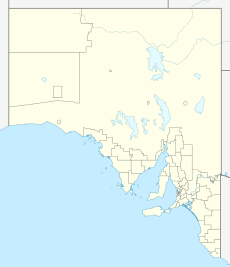world.wikisort.org - Australia
The Hundred of Boolcunda is a cadastral hundred of the County of Newcastle in South Australia.[1] It was proclaimed by Governor Anthony Musgrave in 1876.
| Boolcunda South Australia | |||||||||||||||
|---|---|---|---|---|---|---|---|---|---|---|---|---|---|---|---|
 Boolcunda | |||||||||||||||
| Coordinates | 32.195°S 138.215°E | ||||||||||||||
| Established | 6 July 1876 | ||||||||||||||
| Area | 400 km2 (156 sq mi) | ||||||||||||||
| County | Newcastle | ||||||||||||||
| |||||||||||||||
The principal locality in the hundred is the former township of Willochra.
Local government
Local government was brought to the entire hundred in 1888 with the establishment of the District Council of Kanyaka. In 1969 Kanyaka amalgamated with Quorn council, bringing the hundred under the governance of the District Council of Kanyaka-Quorn. In 1997 the hundred came under the governance of Flinders Ranges Council, with the amalgamation of Kanyaka-Quorn and Hawker councils.
History
The traditional owners of the area are the Ngadjuri peoples/[2] and the first European explorer to the area was Thomas Burr in September 1842. The site of Willochra was surveyed in 1860 but the town never properly developed and was abandoned during the drought in the 1860s.[3]
References
- "Placename Details: Hundred of Boolcunda". Property Location Browser. Government of South Australia. SA0008286. Retrieved 18 October 2017.
Derivation of Name: Native Name; Other Details: Area 156 square miles.
- "Ngadjuri". AusAnthrop Australian Aboriginal tribal database. Retrieved 16 March 2015.
- "Flinders Ranges - Water – life and death". Froling Enterprises. 2013. Retrieved 16 March 2015.
Другой контент может иметь иную лицензию. Перед использованием материалов сайта WikiSort.org внимательно изучите правила лицензирования конкретных элементов наполнения сайта.
WikiSort.org - проект по пересортировке и дополнению контента Википедии